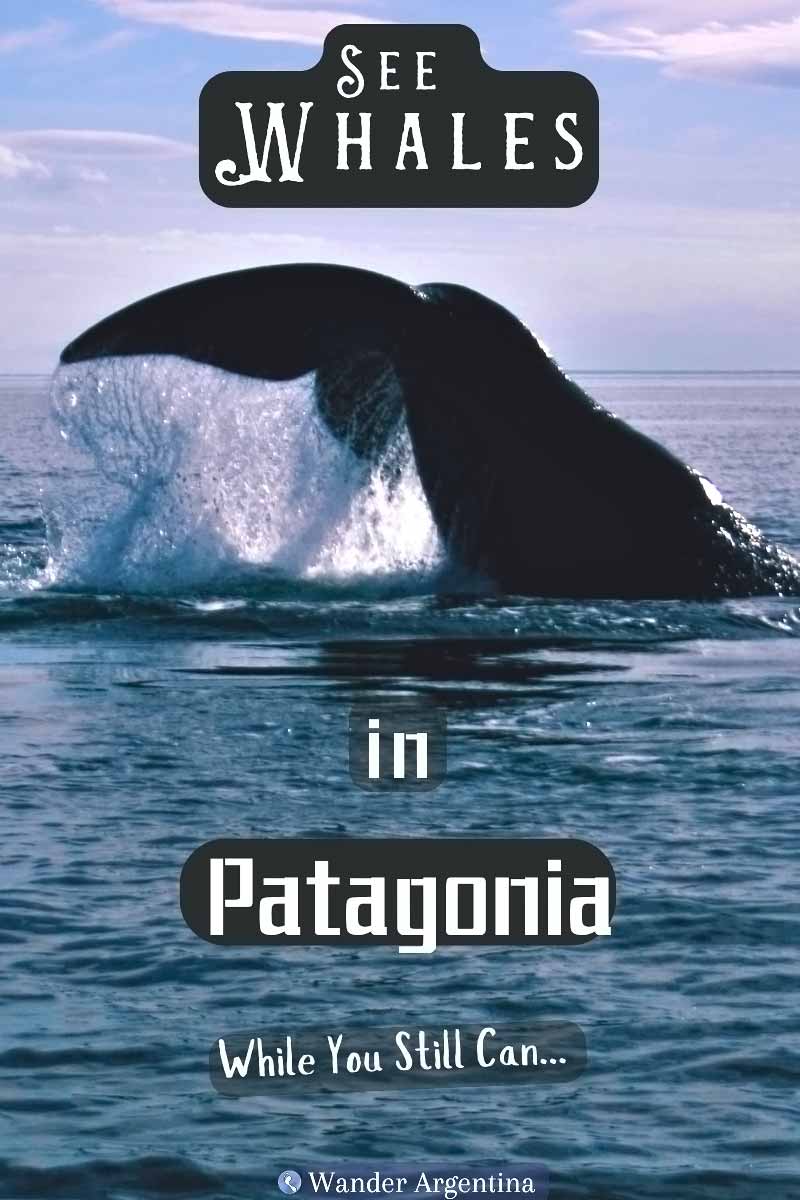Whale-watching on the coastal waters of Patagonia is a transcendent experience that gives a rare glimpse into the life of majestic Southern Right Whales.
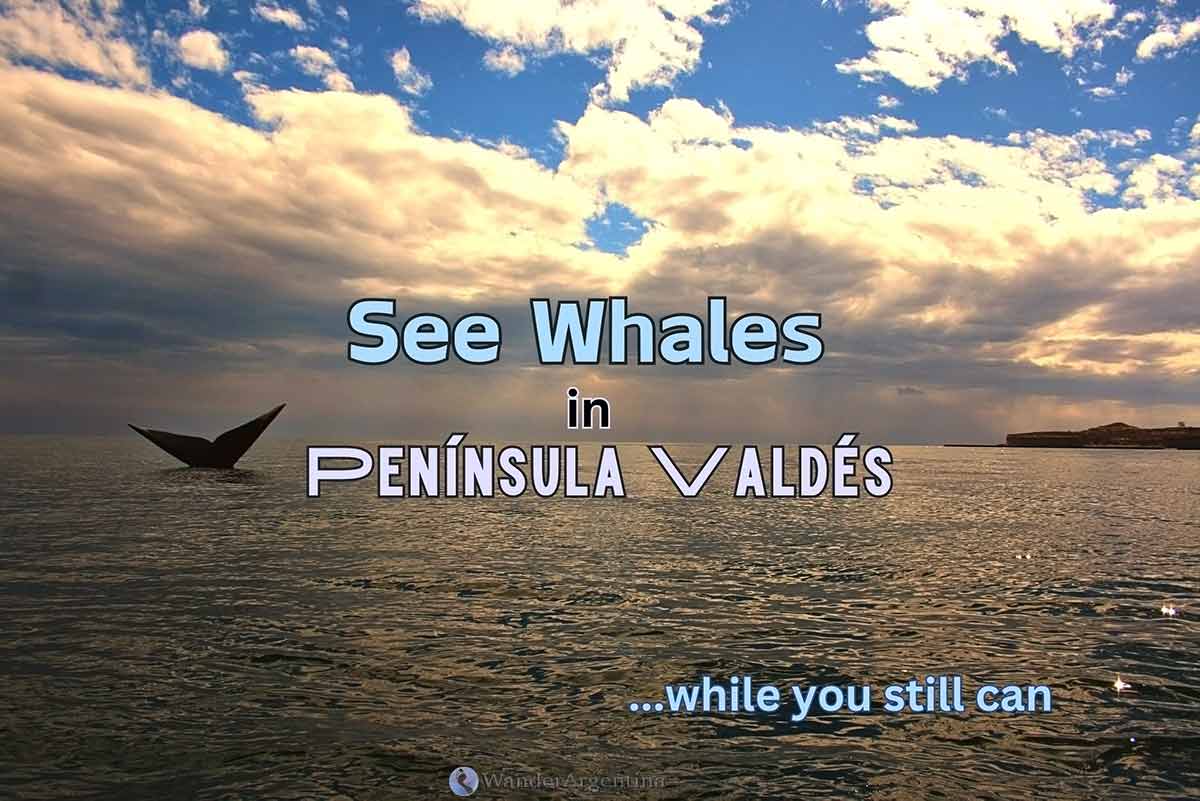
While Argentina boasts several whale-watching locations, the premier destination is the Peninsula Valdés (Valdes Peninsula ) — a protected national reserve that grants a front-row seat to explore the ocean’s wonders.
Whale-watching in Patagonia
Why go: Argentina is home to the world’s premier destination to observe Southern Right Whales’ full life cycle in their native habitat. 🐳
It’s an awe-inspiring once-in-a-lifetime eco-tourism opportunity
When to go: May/ June — November/December (whenever the whales arrive and depart)
Where to go: Penisula Valdés, Chubút, Patagonia, Argentina
How to get there: ✈️Buenos Aires ➡ ✈️ Puerto Madryn or Trelew ➡ 🚘 Penísula Valdés
This post includes affiliate links. If you make a booking we receive a small commission at no extra cost to you ❤️.
Where the Whales Go: Valdés Peninsula, Patagonia’s Marine Playland
A UNESCO World Heritage Site since 1999, Valdés Peninsula is just an hour and a half south of Puerto Madryn in Chubut Province.
To embark on a whale-watching adventure, head to Puerto Pirámides, the peninsula’s sole village, where dramatic cliffs rise above a series of stunning, otherworldly beaches.
The village faces the azure waters of Golfo Nuevo, a marine sanctuary that is home to 50-ton whales, sea lions, seals, penguins, and orcas.
Southern Right Whales: Marine Icons of Patagonia
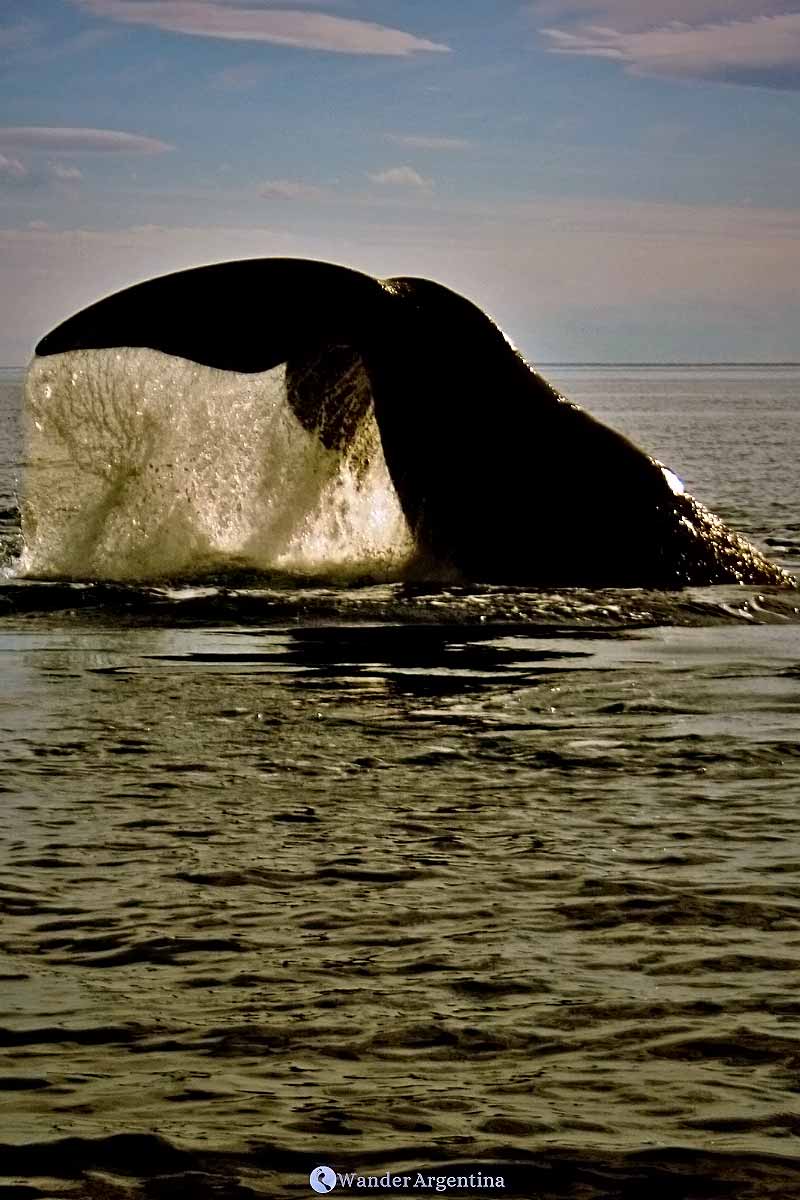
Southern Right Whales (Eubalaena australis) live off the coasts of Argentina, Australia, Brazil, Chile, New Zealand, South Africa, and Uruguay.
But exclusively in Argentina do visitors have the unique opportunity to observe the whole life cycle of the whale, including mating, birthing and rearing calves.
This species has an average lifespan of around 50 to 70 years and lacks a dorsal fin.
They return to this sanctuary year after year, spending the other half of the year in the nutrient-dense waters in the Southern Ocean (near Antarctica).
Depending on the time of year, you may see a newborn calf come up for its first breath, juveniles venturing away from mom for the first time, or a full-size male asserting himself with powerful flipper or tail slaps.
The Spanish term for whale, ‘ballena‘, traces its roots to the word ‘baleen’ – a defining feature of these colossal marine mammals.
Baleen whales, which include humpback, mighty blue whales and Southern Right Whales, use comb-like baleen plates to filter tiny prey like krill and copepods directly from the ocean itself.
Unlike many of their deep-diving relatives, Southern Right Whales typically surface every 5 to 15 minutes to breathe, allowing for great whale-watching.
Their distinctive blowholes create a dramatic V-shaped mist as they exhale.
Known for their curious and social nature, these 50-ton marine mammals reach up to 16 meters long.
The sea creatures here don’t shy away from the daily crowds of ‘whale paparazzi’ who come to see them and may demonstrate typical behavior such as spyhopping, lobtailing, or flipper slapping.
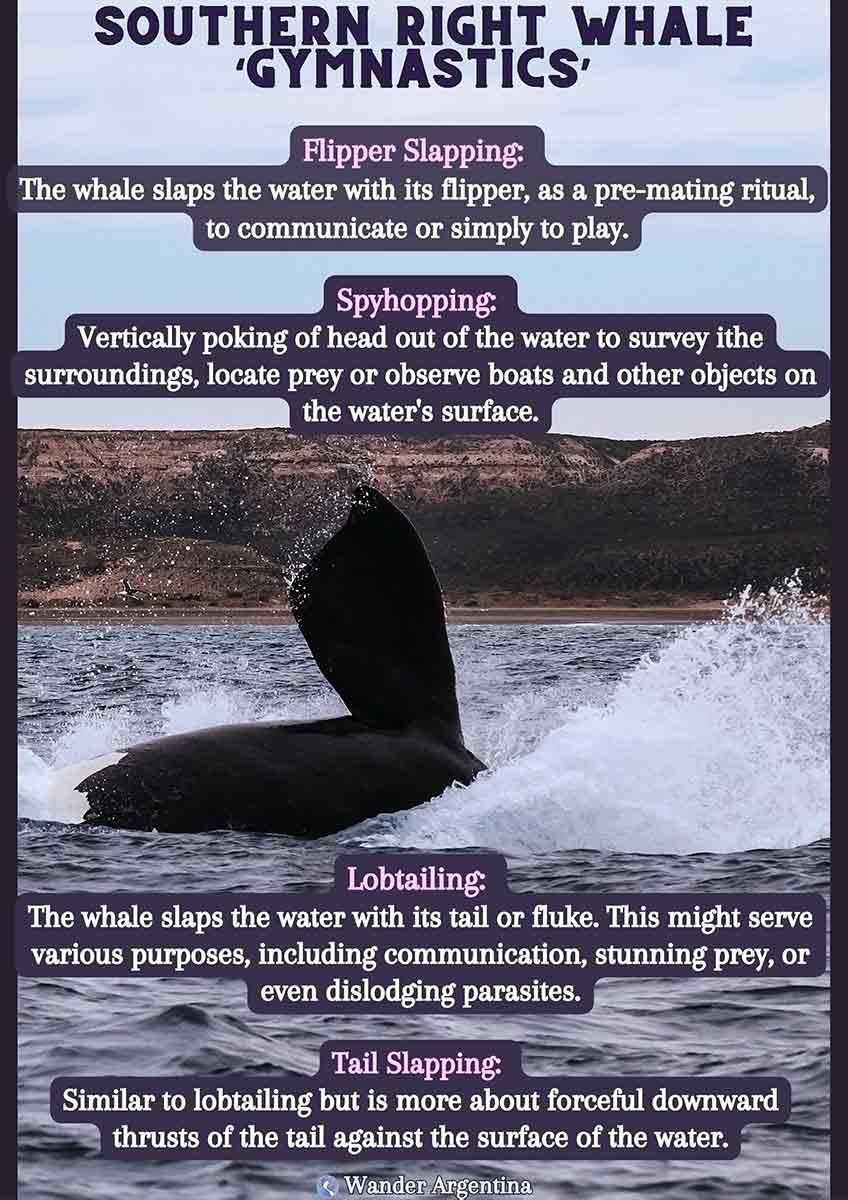
Argentina’s Homegrown Whale-Watching Industry: From Research to Recreation
When renowned whale researcher and conservationist Roger Payne, the galvanizer of the ‘Save the Whales‘ movement, first traveled to Puerto Piramides in 1970, he immediately spotted whales from shore.
Eager to learn more, he enlisted the help of local fishermen, who guided him directly to local whale pods.
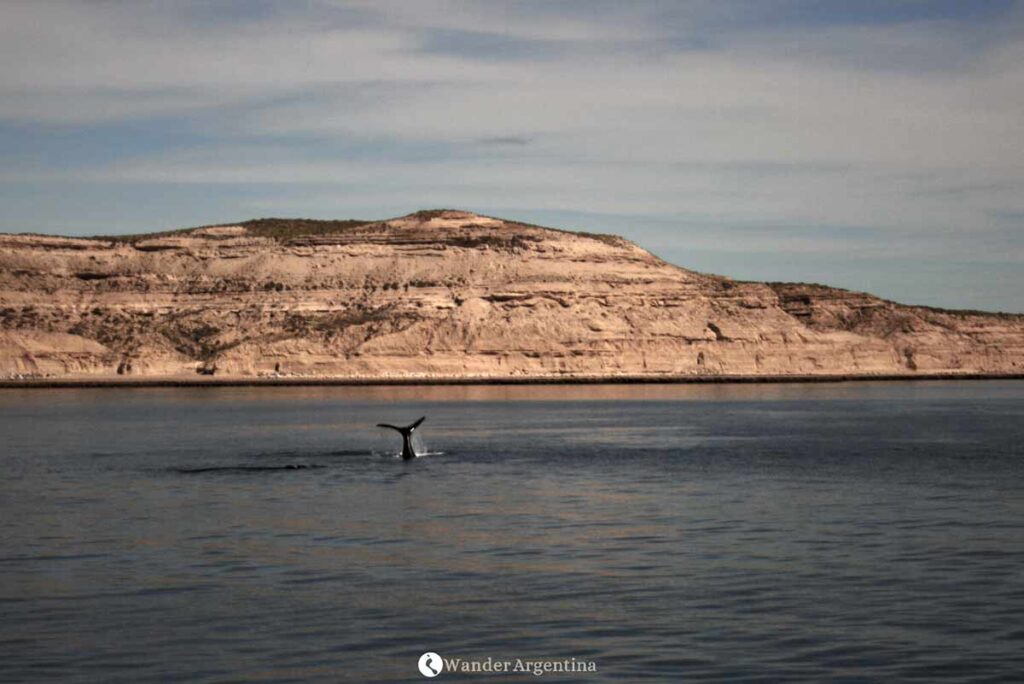
Since then, Puerto Piramides has been home to the longest continuous study of identified whales.
Today the study, conducted with the Instituto de Conservación de Ballenas (ICB, the local chapter of the Whale Conservation Institute) and Ocean Alliance, has the aid of cutting-edge technology, using satellite trackers and drones.
Researchers have cataloged more than 4,100 individual whales and studied their migration patterns throughout the year.
National Geographic, Payne’s sponsor, published fascinating articles on his whale studies in Puerto Piramides, even including flexible phonographs of whale songs in the magazine.
Jacques Cousteau also came here in the early 1970s, featuring Penisula Valdes and the surrounding gulfs in his show ‘The Undersea World of Jacques Cousteau.’
This worldwide exposure sparked public interest and enthusiasm to see whales before the industry even existed.
People started pestering Penisula Valdes’ commercial fishermen to ride along while they fished.
Recognizing an untapped opportunity, the resourceful anglers of Puerto Piramides pivoted their businesses, leveraging the area’s abundant marine life to establish now-thriving eco-tourism ventures focused on whale-watching.
The fishermen-turned-entrepreneurs of Puerto Pirámides continue to exclusively helm the region’s six whale-watching companies: Hydrosport, Peke Sosa Turismo, Southern Spirit, Tito Bottazzi Avistajes and Whales Argentina.
Decades, later the secret is most definitely out about this magical area and Penisula Valdes draws whale enthusiasts from around the globe.
Types of Whale-Watching Expeditions: Boats & the ‘Yellow Submarine’
Most excursions are conducted on sleek catamarans, accommodating between 20 and 70 passengers. They have seats and spacious vantage points to keep an eye on the horizon for whales.
To protect the whales and this delicate ecosystem, the whale-watching companies here developed a minimally invasive whale-watching protocol called ‘The Patagonia Whale Watching Technique‘
Traditional whale-watching tours are available from June, coinciding with the whales’ arrival, until November/December, when they typically depart.
For a different viewing experience, the ‘Yellow Submarine’ semi-submersible tour offers both underwater and above-deck perspectives. This option operates from July to October, coinciding with the peak of whale activity.
All tours are government-certified for safety and environmental sustainability, promising a memorable and responsible encounter with these majestic creatures.
The Whale Expedition
Once everyone is on the boat with life jackets on you’ll set sail.
The captains navigate within a 16-kilometer (10-mile) stretch of the normally calm waters of Golfo Nuevo, communicating with each other to zero in on whale-watching zones and coordinate vantage points.
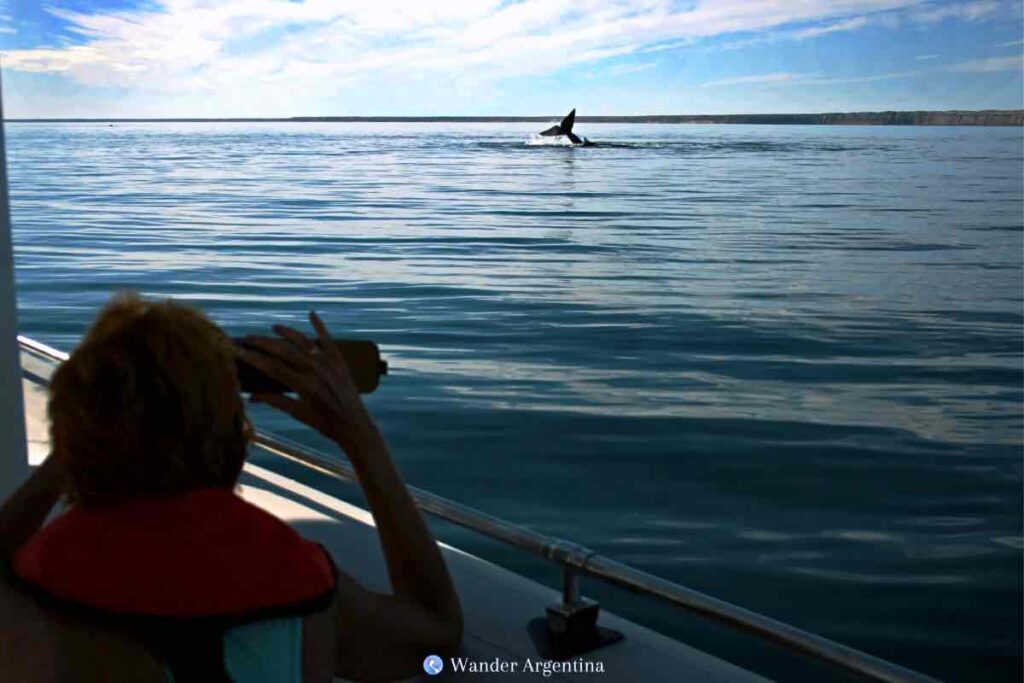
Most stay within Puerto Piramides Bay during high season, where whales are most common, especially when calves are nursing.
Some companies guarantee whale sightings during peak season but Mother Nature doesn’t follow a script.
Savor the experience of being at sea in Patagonia, soaking up the view of the dramatic cliffs over crystal blue water, and expect the unexpected.
Part of the satisfaction of whale watching is knowing that these spectacular mammals have protected habitats, thanks to the conservation efforts sparked by whale watching itself.
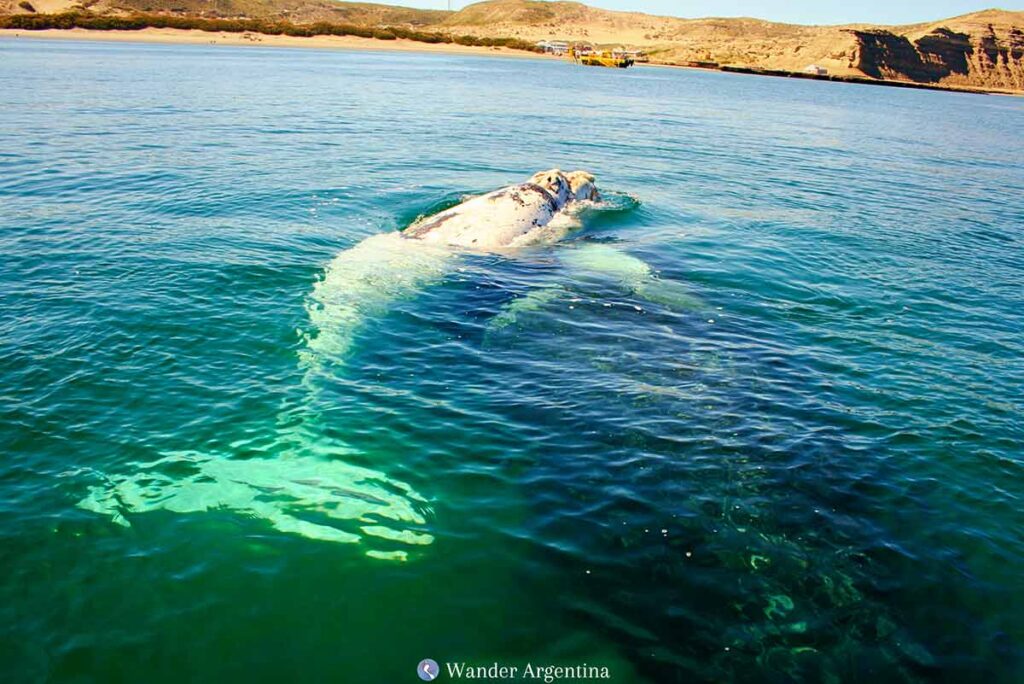
The boat crew and guide are familiar with the whales and can sometimes identify them by their unique callosities (which are like ‘whale footprints’), and share fascinating insights into their histories and behaviors.
When captains approach the nursery area, they keep the engine running briefly.
This is a deliberate technique: since Southern Right Whales use echolocation to navigate, the rumble of the engine helps them locate the boat.
Following the Patagonia Whale-Watching Technique, boats must maintain a 300-meter distance from nursing calves, though the inquisitive baby whales are known to approach the boats themselves.
Have your camera ready and scan the horizon: at any moment whales can breach the surface and splash back into the water.
Delighted passengers will squeal and within one second a memory has been imprinted of an encounter with one of the ocean’s most impressive inhabitants of the deep.
“We were watching whales from a distance until a mother and baby whale came up to the boat,” says Julia Schnell, an American resident of Buenos Aires who went whale-watching here in August.
“The baby seemed curious about us and came up close.
I felt really connected to other species in the universe to see a baby whale being curious about a strange thing, the same way a human baby would.”
The Best Time of Year to see Southern Right Whales
Southern Right Whales grace the waters of Patagonia from June until December.
Each season offers unique opportunities for whale sightings and the chance to observe various wildlife, including guanacos, penguins, sea lions, and orcas, with different species appearing at different times of the year.
➡ Also check our Coastal Patagonia wildlife chart.
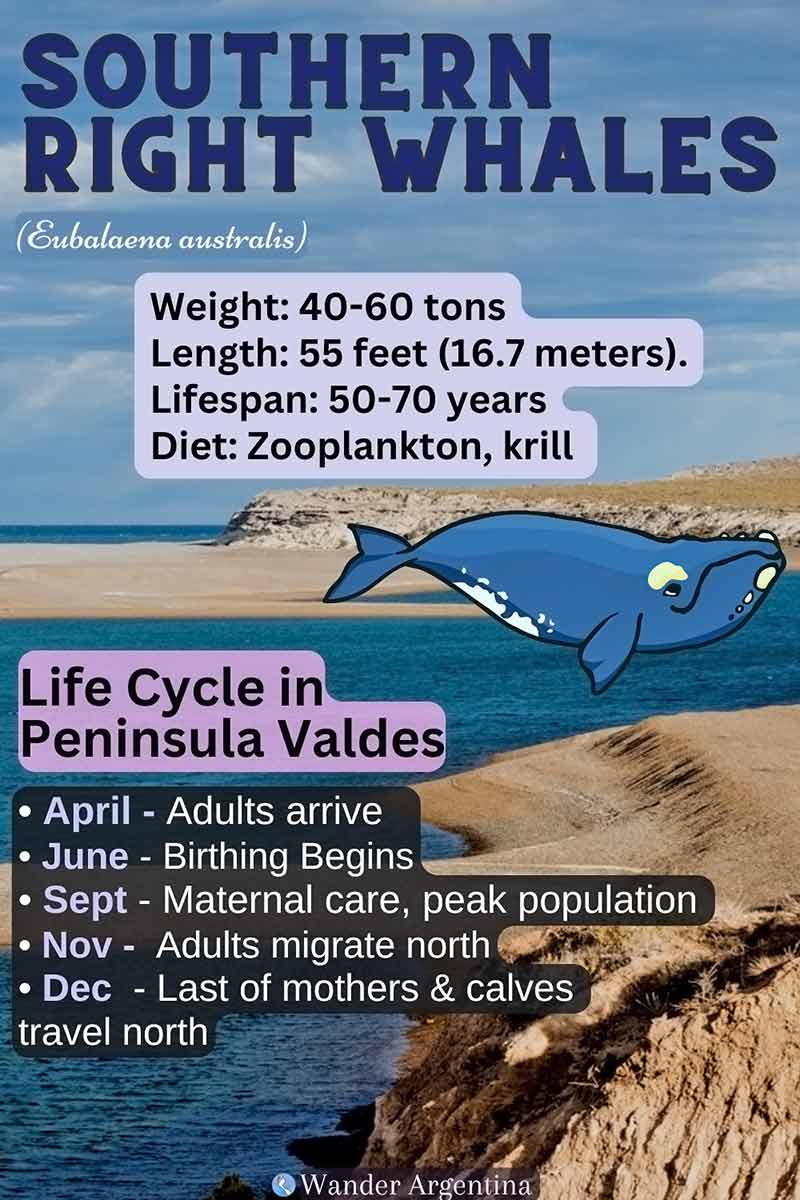
The Winter: Prime Time for Whale-Watching
To celebrate the arrival of the Southern Right whales, usually in mid-June, Chubút province celebrates ‘Whale Week.’
In Puerto Piramides there is a ‘Whales Vigil’ that culminates with the arrival of the whales, to their breeding ground in Puerto Piramides Bay.
Their resplendent arrival can be seen right from the beach in Puerto Piramides and it’s also transmitted worldwide.
Tour operators offer promotions to get people to brave the cooler temperatures to welcome the whales to their winter retreat.
“The majority of visitors come in the warmer months of September, October and November, and December because that is when there is the most wildlife overall, including whales and penguins.
But it is also when there are the most people and high season prices,” says Sanda Stojakovic, whale-watching guide with 15 years of experience (and our contributor).
She urges dedicated cetacean spotters to consider a trip here earlier in the year.
“It’s cold in the winter months of June, July and August obviously, but there are fewer people and that is when the whale population is highest.
It’s also when there are most unique whale behaviors to observe.”
Wintertime is when whales mate and give birth, after a 12-month gestation period.
Whale watchers at this time can witness young whales playing in the water and venturing out on their own for the first time.
Spring: Beautiful Weather & Big Crowds
During high season, Puerto Piramides buzzes with activity, welcoming an average of 1,600 whale watchers each day, all eager to lay eyes on these magnificent marine mammals.
Given the rising popularity of Peninsula Valdés, demand often exceeds supply.
The high season falls in the lovely spring months of September to November requiring advanced reservations, with tours costing up to double the winter prices (but still reasonable compared to Canada and Australia!)
Late Summer: Pursuing Whales Beyond the Bay
As early summer arrives in December, whale watchers still have the chance to spot Southern Right Whales before they migrate to sub-Antarctic waters.
But as the whales start to migrate, tour boats need to venture into deeper waters to find them, resulting in longer travel times and a smaller time window of observation.
The crowds and prices begin to decrease after the peak season though, and it’s likely you’ll see whales but it might be less rewarding compared to the earlier months of winter and spring.
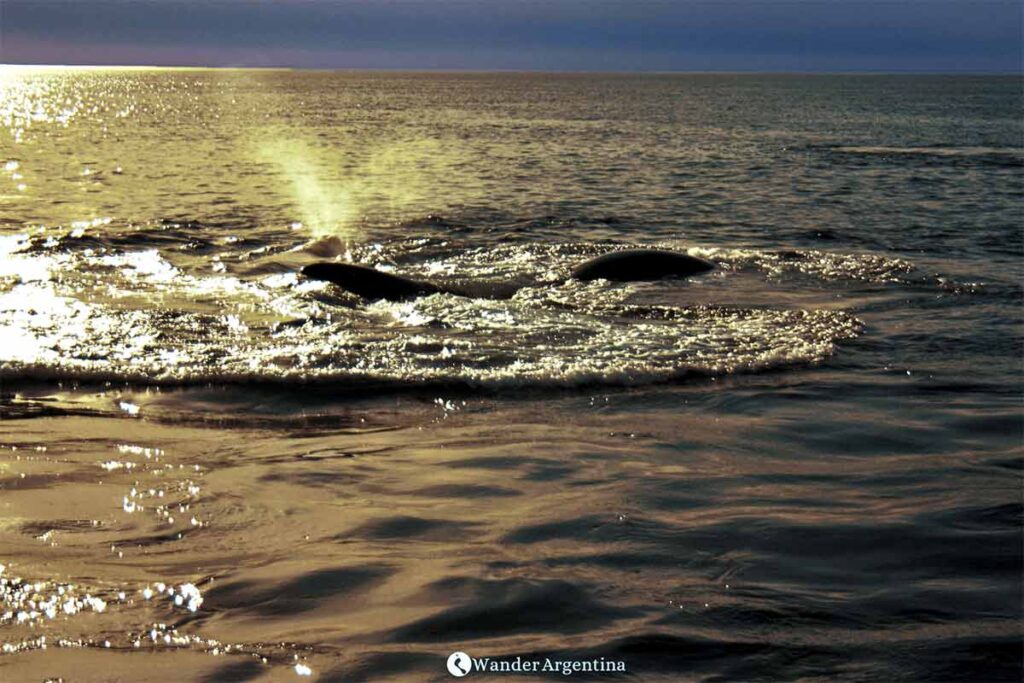
How Long To Stay in Coastal Chubut
And as a prime whale-watching destination, Puerto Pirámides, attracts over 350,000 visitors annually, all eager to spot these stunning sea creatures.
It’s advisable to stay at least three days in the Puerto Madryn area to enjoy all the area has to offer.
In the unlucky chance the weather is bad, boats don’t set sail, so whale-watching tours may be postponed, leading to a backlog.
You also want to allow time for other excursions such as a trip to the penguin reserve at Punto Tumbo and perhaps a trip to the ‘Welsh villages‘ in the area.
Southern Right Whale Conservation Status
Southern Right Whales are believed to have numbered between 55,000-70,000 before whaling.
They are now classified as endangered.
Their plight stems from a history of intense hunting driven by the high 18th and 19th-century demand for whale oil, used as a lubricant and for lanterns.
Southern Right Whales are so named because they were considered the ‘right whale’ to hunt.
Their slow-moving, curious nature made them ready targets and their buoyant blubber meant they were easier to drag ashore.
Today, approximately 1,420 Southern Right Whales inhabit the Golfo Nuevo in Chubút according to the ICB.
This represents the largest population since researchers began meticulously identifying and categorizing the whales using aerial photography and black-and-white photos in 1971.
It’s also on par with late 19th-century estimates, illustrating the severe decline from pre-whaling populations.
By the time the international whaling ban came into effect in 1986, it was too late for some species.
The Tale of Right Whales: Southern Success vs. Northern Crisis
The North Atlantic Right Whale, once believed to be the same species but only a close relative of the Southern Right Whale, is now critically endangered and teetering on the edge of extinction.
Whale species can’t survive ever-increasing industrial activity and cargo ships that choke the vital arteries of our oceans.
Fewer than 340 of Northern Right Whales now cling to life in the Bay of Fundy and the Gulf of Maine.
The U.S. National Marine Fisheries Service (NMFS) has denied repeated requests for emergency protective status for the critically endangered North Atlantic Right Whales, with industry needs winning over whale conservation.
The Northern Right Whale’s plight serves as a sobering reminder of the impact of human activities on marine life and the importance of ongoing conservation efforts to ensure the survival of its Southern counterpart.
The North Pacific Right Whale (Eubalaena japonica), an even closer relative of the same genus, is also critically endangered.
Less than three dozen remain in the Eastern North Pacific and Bering Sea.
Under 200 remain in the Sea of Okhotsk between Japan, Russia, and Siberia.
Save the Whales: A National Monument
In Argentina, whales are classified as a ‘National Monument’ to highlight their cultural significance and ensure their protected status.
Southern Right Whales are nevertheless also classified as endangered.
Collisions with massive cargo ships and the huge cruise lines that dock in Puerto Madryn are the biggest immediate threat to individual whales.
The longer-term danger for the entire species is habitat degradation due to pollution and warming temperatures of the southwest Atlantic Ocean.
Construction began in June 2024 of the Vaca Muerte petroleum pipeline, which will terminate 7 km north in the San Matias Gulf, leading to increased shipping and the looming threat of oil spills.
The Power of Whales: Natural Carbon Capture
Whales aren’t just incredible to see, they play a crucial role in the ecosystem.
According to the U.S. National Oceanic and Atmospheric Administration, each whale sequesters about 33 tons of carbon from the atmosphere over its lifetime,
When whales die, they enrich the ocean floor, supporting the growth of phytoplankton, tiny microalgae that produce more than 50% of the world’s oxygen.
While corporations are racing to invest billions into designing energy-intensive carbon capture systems, whales do the job for free.
Once you’ve experienced the awe-inspiring wonder of whale watching in Península Valdés for yourself, you’ll understand why the rallying cry, ‘Save the Whales‘ resonates from Argentina and throughout the world. 🐳
Getting To Puerto Piramides
✈️Buenos Aires ➡ ✈️ Puerto Madryn or Trelew ➡ 🚘 Penísula Valdés
Most international travelers fly into Buenos Aires and then take another flight to Puerto Madryn or Trelew, the two closest airports.
The ‘Welsh Village‘ of Trelew is 156 km (97 miles) from Puerto Pirámides.
Puerto Madryn is where most people base themselves, and Puerto Pirámides is only 95 km (59 miles) away.
Since there is no bus service on the peninsula you’ll need to, rent a car or take a day tour from Puerto Madryn to get here.
For the ultimate experience in whale-watching reserve accommodation in Puerto Piramides and plan to stay at least three nights to take advantage of other activities.
Make reservations far in advance if you want to stay in Puerto Piramides because there is little accommodation.
There are only a few hundred hotel rooms, so any bed here is a good bed during the peak season.
Even some of the tour employees camp in tents on the beach!
📌 See if there are hotel rooms available in Puerto Piramides ➡
Driving to Puerto Piramides
Driving from Puerto Madryn: Take National Route 3 heading north or Provincial Route 1 (along the coast) to Provincial Route 2, which enters the Valdés Peninsulas.
You will see signs indicating the entrance to the Carlos Ameghino Isthmus, which connects the peninsula to the mainland.
The Welcome Center here is the first stop for entering the National Reserve.
A small fee is required for every entry to the Peninsula.
Check here to check the cost to enter Penisula Valdes ➡ (small change will come in handy)
Once you make your way through the informative Welcome Center, get directions or a map (wifi signals aren’t too strong here) to Puerto Pirámides if you’re going whale-watching directly.
Be prepared for gravel roads. You only need a 4×4 if there are heavy rains, which are most likely in June, moderately likely during spring, and not likely in November and December.
Once in ‘Pirámides’ as it’s known to locals, finding your specially-equipped whale-watching vessel will be no problem — the village is tiny.
Climb aboard for a mind-blowing experience exploring the real-life mundo marino (marine world) of Golfo Nuevo.
➛ Full Day wildlife tour on Peninsula Valdes including whale watching. 🐳
A full-day wildlife tour with a whale-watching excursion lets you see other marine life such as sea lions and, depending on the time of year possibly orcas, gigantic sea elephants, Magellanic penguins, and seals.
